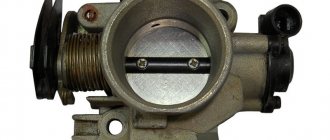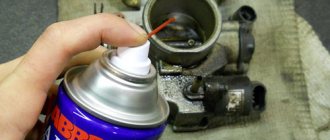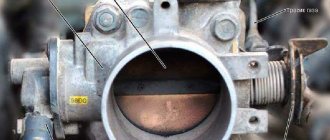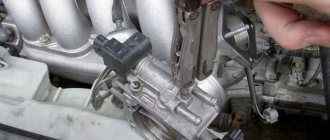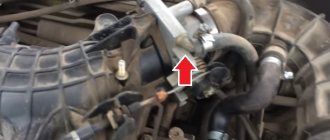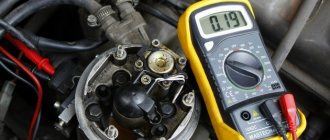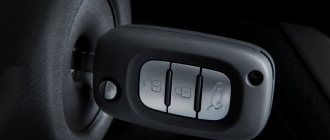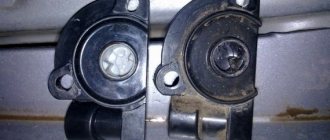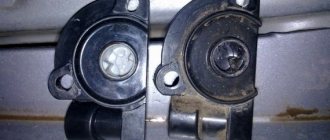What is a throttle body pipe?
Throttle pipe
— the air supply system to the engine, assembled, contains several sensors: TPS (
throttle
), IAC (idle air control).
Interesting materials:
What do the information signs mean? What does each traffic light color mean? What does a hashtag mean? What does a red traffic light mean? What does the red triangle mean? What does torque mean? What does m s mean on tires? What does the m stand for on a driver's license? What do the markings on tires mean? What does commercialism mean?
Turn off the throttle valve heating
This activity is usually carried out in the spring-summer period; in winter, the heating of the remote control is switched back on. The implementation of the plan occurs as follows: a special fitting, clamps and a small piece of rubber hose are bought in the store. The coolant inlet and outlet hoses are disconnected and connected to each other using a special adapter fitting, bypassing the throttle assembly. To prevent anything from getting inside the coolant inlet and outlet on the throttle assembly, it is necessary to plug the holes using a hose that fits onto the corresponding fittings.
Electronic throttle valve: how does it work and how to repair it?
The trend in automotive engineering in recent years has been the systematic removal of the driver from direct control of the car. So far, thank God, we have not reached the point of losing the rigid connection of our arms and legs with the turning wheels and brakes, but everything is clearly heading that way... At least, not a single car these days is produced without an electronic throttle, with which we We do not give a direct command to the throttle “more air!” with the right foot through the cable, and express a wish to the engine control unit, which itself sends a command to the damper. Is this good or bad, and how to live with it?
Background
It is generally accepted that the so-called E-gas is a technology of the last decade or so. In its pure form - yes, but the integrated electric drive in throttle valves appeared much earlier - back in the 80s. In those years, on the damper axis, on one side there was a gas sector connected to the accelerator pedal with a classic cable (yes, the “wheel” that is driven by a cable from the pedal is called the “gas sector”!), and on the other side, the damper axis connected through a gear transmission to a small electric motor.
Actually, the motor had no influence on the behavior of the car when moving - the connection with the driver’s foot was old-school, mechanical and clear: as you press, so will you go! And the electric motor started working only in idle mode, adjusting the speed of the damper slightly during warming up and after warming up, and also slightly adding gas when turning on powerful consumers of electricity and torque - air conditioning in the summer, power steering in the cold, various heating systems, etc. A little later, the functions of the motor in the throttle expanded - with an almost unchanged design, electronic commands were added: it began to control not only idle speed, but also speed while driving - when the cruise control is turned on and when the traction control system is activated.
Now everything has reached the “apophygea of technology” - the mechanical connection between the damper and the gas pedal has disappeared in principle, and all commands - both from the driver’s foot and from service systems - are received by the throttle only through the mediation of the engine control unit. There are three reasons for this:
- Environmental requirements;
- Increased fuel economy;
- Convenient implementation of many modern car functions.
Electronic throttle these days
So, the direct connection between the throttle valve and the pedal has been completely and completely abolished. As I already said, by pressing the pedal we send a signal to the control unit, which in turn analyzes the situation and many parameters, and then issues a command to supply air. At the same time, it must be said that over a good ten years of development of the tandem of an electronic gas pedal and an electronic throttle in its modern understanding, the system has successfully outgrown a number of childhood diseases - both purely physical and software.
Wearing sliding contacts of damper position sensors have been replaced by non-contact inductive coupling, and many new functions have appeared - not so obvious as to take a line in the technical description of the car, but quite important in the complex.
For example, the gas pedal travel has become non-linear, which makes it possible to better control the car when starting to move: with a powerful engine (where the damper has a large diameter), the risk of excessively rushing forward when lightly touching the pedal has disappeared - the electronic throttle reacts deliberately sluggishly in the first quarter of the gas pedal travel .
E-gas allows for the most optimal acceleration in a car with a turbocharged engine, significantly combating turbo lag and providing smoother acceleration from the bottom. E-gas will also help in the “pedal to the floor” mode, when in the case of a classic cable damper, the first moments of non-optimal combustion of the mixture occur, and seconds are lost during acceleration. Of course, we cannot fail to mention the effective automatic engine traction control system to combat drift and slippage of the drive wheels .
However, it should be noted that the behavior of the electronic throttle on budget cars is still seriously different from mid-price and, especially, premium cars. In “budget” cars, E-gas, unfortunately, is too dull, thoughtful and does not contribute to getting true pleasure from the drive.
Moreover, sometimes it has a negative impact on safety - a throttle with suboptimal control software reacts to pedal pressure with a delay, delivering torque to the wheels when it is already too late. In the absence of stabilization systems in winter on slippery surfaces and when turning, such a car reaction can negate your traditional winter driving skills and create an emergency situation.
The simplicity and complexity of electronic throttle
Typically, the introduction of electronics is accompanied by incredible complication of the design. In the case of the throttle, everything is exactly the opposite! Having carefully studied it, you will find that it is incredibly simple and devoid of a number of tricky technical solutions that were previously available in classic cable-driven chokes. And the good old two-chamber carburetor, compared to the E-choke, is the most complex and expensive device of the steampunk era to produce...
Firstly, of course, the E-throttle does not need an idle air regulator - an air supply valve through a thin channel controlled by a stepper motor, which is prone to contamination by crankcase gases and unstable operation. In the case of an electronic throttle, the idle speed control valve disappears - idle speed is ensured by slightly opening the main damper - after all, it is already electrically controlled, and therefore copes well with adjusting the speed, adapting to the switched on consumers, the temperature of the outside air and antifreeze, etc.
Even the idle system with a classic throttle often included additional bypass air channels that bypassed the damper, which were also very prone to clogging. These channels did not open smoothly, but according to the “on/off” principle, using external electric valves - for example, to compensate for the load on the engine when the air conditioner was turned on. In the electronic throttle, all this also turned out to be unnecessary - compensation for the drop in speed is again done by the throttle valve itself.
Helpful information:
You can get professional advice when selecting a product and detailed information on all your questions by calling -
Read also: Astheno-vegetative syndrome
8 (calls within Russia are free).
The throttle valve (throttle unit (DZ and DU, respectively)) is necessary to regulate the air flow, which is necessary for preparing the fuel-air mixture (FA) entering the cylinders. During operation of the remote control, its excessive cooling occurs, resulting in interruptions in engine operation.
Heated throttle VAZ 2110 8 valves
- To the beginning of the forum
- Forum Rules
- Old design
- FAQ
- Search
- Users
I don’t really care, I turned it off, period. , I may return it for the winter if I notice that it will “coke”
oil in the throttle or something will freeze and freeze (just before shutting it off, I cleaned the entire receiver and throttle, so I have an idea of the amount of oil and dirt that was in them, so we’ll see in another 50 thousand whether this will have an effect) IMHO, nonsense that's all, and according to my observations, turning off the throttle heating does not affect anything 
I’ve already ridden in super-humid weather at a temperature of about 0 on the highway, at high speeds, and there were no problems with anything


